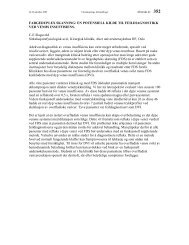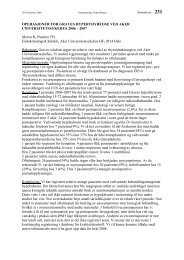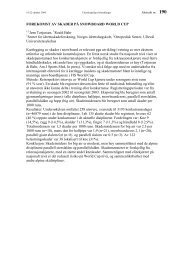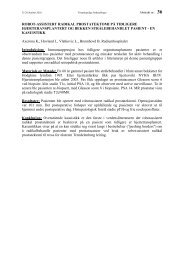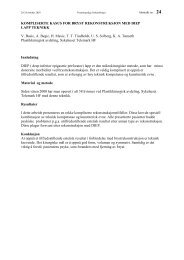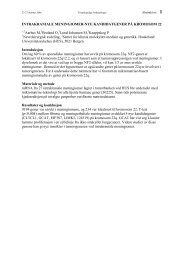Ortopedi
Ortopedi
Ortopedi
Create successful ePaper yourself
Turn your PDF publications into a flip-book with our unique Google optimized e-Paper software.
23-27 oktober 2006 Vitenskapelige forhandlinger Abstrakt nr: 229<br />
MECHANICAL CONDITIONS DETERMINE THE GEOMETRY OF THE<br />
EPIPHYSIS<br />
Huiskes R, Braam S, Foolen J, van Donkelaar R<br />
Eindhoven University of Technology, Dept Biomedical Engineering<br />
Den Dolech 2, WH 4.131, PO Box 513, 5600 MB Eindhoven, The Netherlands<br />
Introduction: Fetal long-bone growth is the result of growth and subsequent mineralization of<br />
the cartilaginous epiphyses. Hence, the shapes of the epiphyses determine the geometries of<br />
the proximal and distal ends of long bones prior to bone remodeling. These regions contain<br />
many bony prominences which are important for bone functioning. It is unclear how<br />
morphogenesis of the epiphyses is controlled. Various developmental studies suggest that<br />
biochemical control processes and mechanical loading are both involved.<br />
We previously developed a 1D bone-growth model in which epiphysis development is<br />
controlled by the growth factors Indian hedgehog (Ihh), PTHrP and VEGF. The present study<br />
uses this finite element model to assess the effect of additional externally applied mechanical<br />
loading on the morphogenesis of the epiphysis.<br />
Methods: A 2D representation of a 16-days old anlage of a mouse metatarsal bone is used as<br />
the initial geometry in our finite element model of fetal bone development. This anlage only<br />
consists of cartilage and is not yet mineralized. We simulate bone development over several<br />
days during which the cartilage grows and mineralizes. This process is fully controlled by<br />
PTHrP, Ihh and VEGF. First, the computed and experimentally observed shapes of metatarsal<br />
bones at embryonic day 19 are compared for validation. Subsequently, two extended<br />
simulations are performed, one with and one without the presence of additional external<br />
loading.<br />
Results: The computed geometry compares well with the geometry of a mouse metatarsal<br />
bone at embryonic day 19. Without external mechanical loading in the extended simulation,<br />
the epiphysis develops a circular, non-physiological geometry. Both the application of<br />
mechanical constraints against growth and tensile forces during growth, significantly<br />
influence the geometry of the epiphysis.<br />
Discussion: External mechanical forces importantly determine the shape of the epiphysis<br />
during development. These forces drive bone morphology to a physiological geometry.<br />
External mechanical forces may arise from muscle contractions as well as from tensile forces<br />
which develop during growth due to stretching of tendons, ligaments, periosteum and<br />
perichondrium. It is challenging to determine the relative importance of these structures to<br />
eventual bone morphogenesis.



